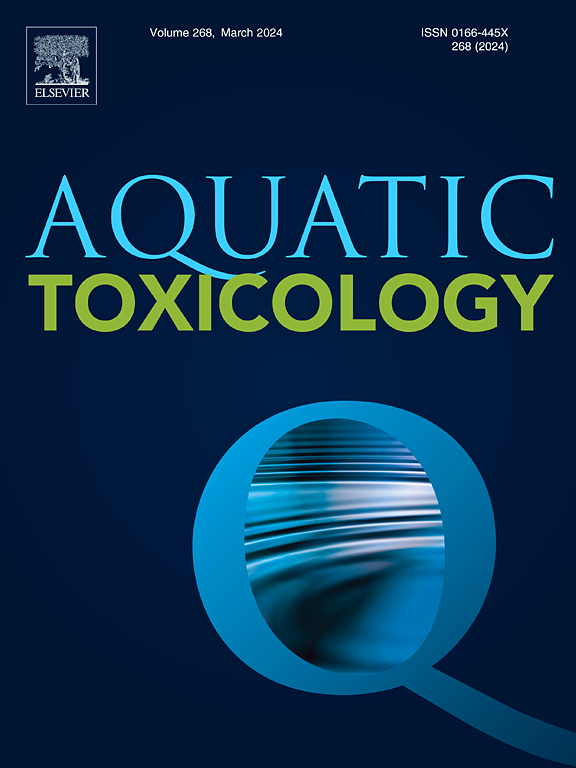Neurodevelopmental toxicity and mechanism of action of monoethylhexyl phthalate (MEHP) in the developing zebrafish (Danio rerio)
IF 4.1
2区 环境科学与生态学
Q1 MARINE & FRESHWATER BIOLOGY
引用次数: 0
Abstract
Monoethylhexyl phthalate (MEHP) is the primary metabolite of di(2-ethylhexyl) phthalate (DEHP), the most prevalent phthalate plasticiser globally. It has been demonstrated that MEHP exerts more potent toxic effects than DEHP. Nevertheless, the full extent of the toxicity of MEHP to neurodevelopmental organisms remains unclear. Accordingly, the present study was designed to investigate the neurodevelopmental toxicity of MEHP exposure and the underlying molecular mechanisms. Zebrafish juveniles were exposed to different concentrations of MEHP (7.42, 14.84, 29.68 and 74.2 μg/L) for a period of four weeks. Immunohistological evidence indicated that MEHP exposure resulted in oxidative stress and apoptosis in the developing zebrafish brain. Subsequently, the neurobehaviour of zebrafish larvae was evaluated, and it was determined that MEHP significantly disrupted their locomotor capacity, motor vigor, and social conduct. Furthermore, HE staining revealed damage to brain neurons, which may be linked to impaired synthesis and conduction of inter-synaptic neurotransmitters. Transcriptomic analyses indicated that MEHP may affect the expression levels of genes in the P53 signalling pathway and signalling pathways related to the development of the nervous system. This results in impaired functions, including nerve conduction and neuronal development. Additionally, it induces oxidative stress, which leads to significant brain cell apoptosis and, ultimately, neurotoxicity in developing zebrafish.

邻苯二甲酸一乙基己基酯(MEHP)对发育中的斑马鱼的神经发育毒性及作用机制
邻苯二甲酸一乙基己基酯(MEHP)是邻苯二甲酸二(2-乙基己基)酯(DEHP)的主要代谢物,邻苯二甲酸二酯(DEHP)是全球最普遍的邻苯二甲酸酯增塑剂。已经证明,MEHP比DEHP具有更强的毒性作用。然而,MEHP对神经发育生物体的毒性程度仍不清楚。因此,本研究旨在探讨MEHP暴露的神经发育毒性及其潜在的分子机制。将斑马鱼幼鱼暴露于不同浓度的MEHP(7.42、14.84、29.68和74.2 μg/L)中4周。免疫组织学证据表明,MEHP暴露导致发育中的斑马鱼大脑氧化应激和细胞凋亡。随后,对斑马鱼幼虫的神经行为进行了评估,确定MEHP显著破坏了斑马鱼的运动能力、运动活力和社会行为。此外,HE染色显示脑神经元损伤,这可能与突触间神经递质的合成和传导受损有关。转录组学分析表明,MEHP可能影响P53信号通路及神经系统发育相关信号通路基因的表达水平。这导致功能受损,包括神经传导和神经元发育。此外,它还会诱导氧化应激,从而导致脑细胞凋亡,并最终导致发育中的斑马鱼的神经毒性。
本文章由计算机程序翻译,如有差异,请以英文原文为准。
求助全文
约1分钟内获得全文
求助全文
来源期刊

Aquatic Toxicology
环境科学-毒理学
CiteScore
7.10
自引率
4.40%
发文量
250
审稿时长
56 days
期刊介绍:
Aquatic Toxicology publishes significant contributions that increase the understanding of the impact of harmful substances (including natural and synthetic chemicals) on aquatic organisms and ecosystems.
Aquatic Toxicology considers both laboratory and field studies with a focus on marine/ freshwater environments. We strive to attract high quality original scientific papers, critical reviews and expert opinion papers in the following areas: Effects of harmful substances on molecular, cellular, sub-organismal, organismal, population, community, and ecosystem level; Toxic Mechanisms; Genetic disturbances, transgenerational effects, behavioral and adaptive responses; Impacts of harmful substances on structure, function of and services provided by aquatic ecosystems; Mixture toxicity assessment; Statistical approaches to predict exposure to and hazards of contaminants
The journal also considers manuscripts in other areas, such as the development of innovative concepts, approaches, and methodologies, which promote the wider application of toxicological datasets to the protection of aquatic environments and inform ecological risk assessments and decision making by relevant authorities.
 求助内容:
求助内容: 应助结果提醒方式:
应助结果提醒方式:


